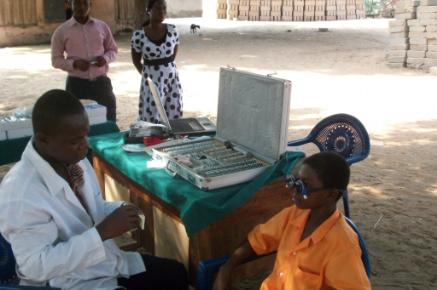
 | Vision testing program targets schools because these constitute a ready catchment area for the age groups 5 – 21 years. This age group is important because many of them suffer from defective sight but are unaware of. Defective sight is not easily diagnosed as it may manifest and /or is perceived differently in this age group. Some youngsters may complain of headaches, frontal headaches, painful eyes, fatigue, inability to concentrate, others may simply be lazy and unable to live up to the school expectations. Some may simply suffer some kind of sleeplessness after straining to read over a time. Children with inherited / or congenital visual defects may never see well and do not understand and speak about poor vision let alone complaining. These categories of children will eventually suffer low vision because they may never be detected. Detecting children with defective sight requires making deliberate attempt to access them in their communities. It also entails giving out appropriate information to empower family and community members to be able to identify and bring children with defective vision to the eye care centers. It can also be done through peer groups by reinforcing those positive and supportive attitudes to early detection of those with defective sight. These and many more can happen along during vision testing in schools. GLOBAL OBJECTIVE To screen, detect and treat all eye conditions that may lead to visual impairment in targeted schools (primary, secondary and high schools) found in the NW region of Cameroon. Specific objectives To advocate for school vision testing within the framework of schools; To seek and obtain consent and collaboration for carrying out school vision testing activities in schools (public and private alike); To screen, counsel and treat /or refer all children found with visual impairment; To develop and carryout information, education and communication on eye health in schools; To be able to generate indigenous statistics on defective sight and related issues in schools; STRATEGIES Vision testing done through volunteers (teachers, students, etc) who accept and submit themselves for simple, practical and task oriented training. Pre-referral counseling and eventual referral to specialists (St. Patrick's Eye Clinic) for further examination. No fee charges for screening, charges levied only for treatment or glasses prescribed after further examinations in eye centers. Regular supervision and continuous training of volunteers through refresher courses. Efficient record keeping and reporting on the activities ,which will reflect on the different age groups, the findings, the interventions, the outcomes and general impact on the schools. PROCEDURE Authorization to be obtained from appropriate quarters for the activities Authorization and introductory letter to be forwarded to the institution under consideration Team self introduction with information, education and communication sessions to follow before actual vision testing proper. SCHOOL VISION TESTING PROTOCOL School vision testing done for the ages 5—21 years. This is the age at which myopia (short sightedness) starts and manifests Vision testing done in school premises. Handling, movement and cooperation of students can easily be done in the presence disciplinary masters Simple method of vision testing will be done with the Snellen chart. A hand held E model to be used to demonstrate how to read on the chart. Cut off point at 6/12, this will enable that every other vision impairing condition to be detected All children who can’t read beyond the 6/12 level to be referred for further examination and refraction to the base clinic. All referral done with the consent of the parents or significant others. Follow up examinations and refraction done at the base clinic except or otherwise requested by school administration. Vision testing to be done by trained volunteer teachers, students and team from clinic. Vision testing at schools is done free of charge. Those who require further examination and refraction will pay for medications/ glasses if prescribed All referred children are registered at the point of referral and also on reception at the base clinic. All those referred carry along a referral note. Statistics done of the number of children screened and referred, (also, ages, sex). Periodic statistics /reports produced to see the trend of activities and thus evaluation of the program. Entire targeted school populations could be screened twice in 5-7 years within targeted communities
|
*Home *About us *Mission *The Founder *Projects *Membership *Donations *Contact us Powered by Rokman